[ad_1]
19
Feb
2021
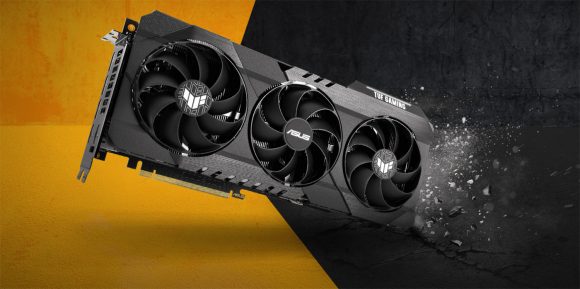
We’ve managed to get a Nvidia GeForce RTX 3080 GPU to play around with mining Ethereum and other cyrpto coins, though here we are going to be focusing on ETH mining. The RTX 3080 is really hard to find on the market at the moment and if you manage to find stock somewhere the price will be so high that you probably would consider buying a RTX 3090 instead. We managed to somehow get our hands on a single ASUS TUF Gaming GeForce RTX 3080 (ASUS TUF-RTX3080-10G-GAMING) video card to play around with it for crypto mining and below you can read what we have found out using this GPU.
This TUF Gaming RTX 3080 from ASUS is definitely not the greatest model you can find and definitely not as impressive as some other cards, but still, at the moment it is what you can find and you cannot be too choosy. The TUF RTX 3080 works and performs really well and the cooling manages to keep the card cool while mining even with stock out of the box settings. The ASUS TUF Gaming GeForce RTX 3080 comes with dual 8-pin PCI-E power connectors, 2.7-slot cooling solution that works surprisingly well with the three fans on top of the radiator. The default specifications of the ASUS TUF Gamin RTX 3080 are the ones that the reference design Nvidia RTX 3080 uses and although that may not be that great for gamers or PC enthusiasts it is perfectly fine as far as Ethereum mining is concerned.
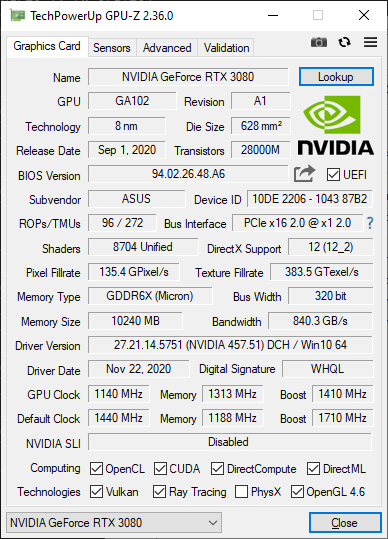
The card comes with a 1440 MHz Base clock, 1710 MHz Boost Clock, 1188 MHz Memory clock (19 Gbps effective) and a 320W TDP. The RTX 3080 video card comes equipped with 10GB of GDDR6X video memory that has a 320-bit wide memory bus. There are 8704 CUDA cores, 272 TMUs and 96 ROPs in the large graphics processor that consists of over 28 million transistors. One hell of a graphics monster that is only bested by the even faster and better in terms of performance Nvidia GeForce RTX 3090, including the crypto mining performance as well.
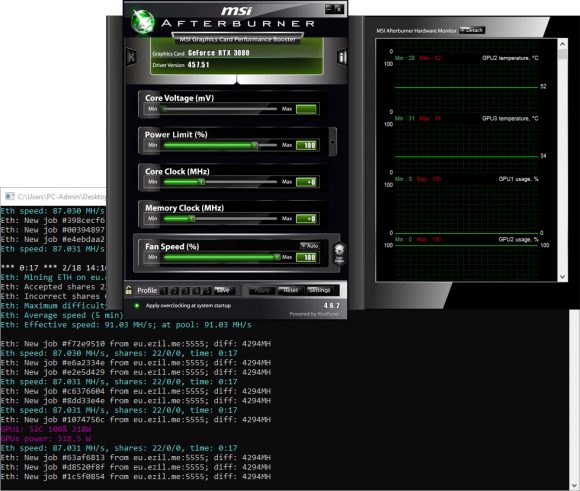
Using the ASUS TUF Gaming GeForce RTX 3080 with its default out of the box settings for mining Ethereum (100% TDP, no clocks and fans at 100%) got us at 87 MH/s Ethash mining hashrate. This is a great result in terms of performance, though with default settings the GPU uses around 320W of power and that can be reduces with some optimizations for sure. With the cooling fans running at 100% even the 320W of power usage while mining is not much of an issue with the average GPU temperature at around 52 degrees Celsius. With a bit of tweaking however we can optimize performance and reduce power quite well making the Nvidia GeForce RTX 3080 even better for mining Ethereum for sure…
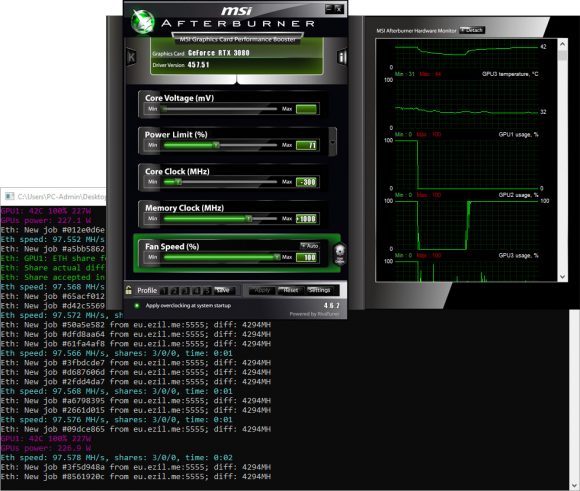
Reducing the power usage from the default TDP level of 320W to just 71% TDP got us to 230W of power usage for the RTX 3080 with even higher hashrate. We’ve set the GPU clock at -300 MHz and the memory at +1000 MHz in MSI Afterburner resulting in 97.5 MH/s hashtrate mining Ethereum. The RTX 3080 can handle a bit higher overclock at +1100 for an extra megahash of performance, so you might want to try that as well, though we are fine with the lower clock as the cooling solution on this particular RTX 3080 form ASUS is not the best you can find on 3080 GPUs. And we like our GPUs not pushed to the absolute maximum when mining, but at a bit more conservative settings, but running rock solid for a very long time and you should probably adopt the same philosophy as well.
Optimized RTX 3080 Mining Settings:
– TDP: 71%
– GPU: -300 MHz
– VRAM: +1000 MHz
– FANs: 100%
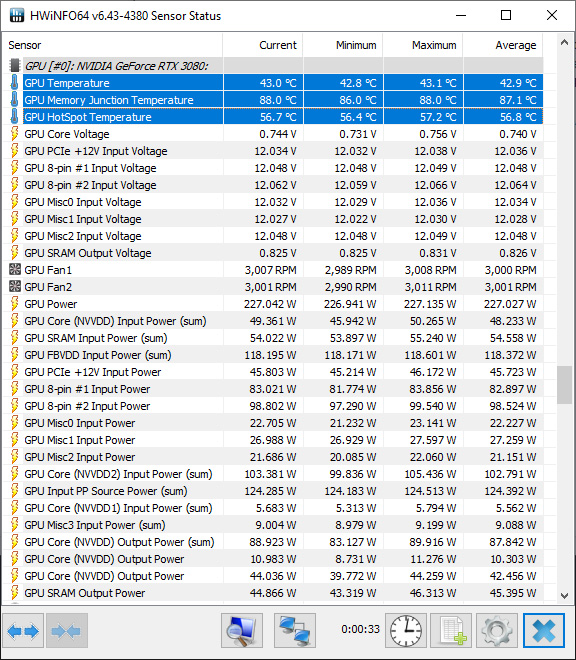
Since now we can measure the operating temperature of the GDDR6X memory chips with the HWiNFO tool we are going to be monitoring that as well as it is important to keep the video memory at the lowest possible temperature due to these new fast chips getting quite hot under load. We would not only want to avoid getting the memory up to a level when it begins to throttle (around 110 degrees Celsius) and starts dropping the hashrate, but also to have it running as cooler as possible. This is one of the reasons why we use 100% for the cooling fans, even though the GPU is not getting that hot at 52 C and can handle lower fan speed without increasing its operating temperature much.
Another interesting feature that was more recently introduced in the HWiNFO tool is the ability to HotSpots on Nvidia GPUs, so that besides the average working temperature that all monitoring tools report for the GPU you can now know what is the hottest spot. This is especially useful for diagnosing potential issues with GPUs that have been mining for a while and are showing some instabilities due to things such as bad thermal grease or bad cooler contact. Here we see that the hottest spot of the RTX 3080 GPU is around 13-14 C hotter than the average operating temperature reported for the GPU and this is kind of normal, but then again this is a brand-new GPU.
The GPU Memory Junction temperature that we are measuring during Ethereum mining with overclocked VRAM with +1000 MHz in Afterburner is at 88 degrees Celsius with the fans at 100%, without the clock for the memory it runs at around 82 C, so the extra clock does not make things much hotter. For instance, on RTX 3090 we are seeing operating temperatures that are around 10 degrees higher than the ones measured here under similar conditions. This is due the fact that the RTX 3090 had memory chips on both sides due to the larger memory config, so the RTX 3080 is doing better, but the temperature is still pretty high in our opinion for 24/7 operation. Still, if you manage to get things running at under 100 C for RTX 3080/RTX 3090 it should be fine, but you should try to reduce the temperature of the hottest memory chip to around 90 at least with a better airflow for instance.
Getting 97-98 MH/s hashrate for mining Ethereum (ETH) using the Ethash crypto algorithm is easily achievable on Nvidia GeForce RTX 3080 GPU with around 230W of power usage. This should be possible on pretty much all reference designs (specs wise) like the ASUS TUF that follows the base specifications set with the Nvidia Founders Edition GPUs. Some models with further increased operating clocks and voltages may require extra tweaking or different settings in order to achieve similar performance at the same power usage level, though they should still be able to get you the same hashrate if you manage to keep things running cool.
– For More Information about the ASUS TUF Gaming GeForce RTX 3080 GPU…
– What Hashrate to Expect from an ASUS EKWB GeForcce RTX 3090 Do Mining Ethereum…
- Publihsed in: Mining Hardware|Tests and Reviews
- Related tags: ASUS RTX 3080 TUF Gaming, ASUS TUF Gaming, ASUS TUF Gaming GeForce RTX 3080, ETH, ETH mining, Ethash mining hashrate, Ethash mining performance, Ethereum, Ethereum mining, GDDR6X ETH, GDDR6X Ethash, GDDR6X Ethereum, GDDR6X hashrate, GDDR6X performance, Nvidia GeForce RTX 30 series, Nvidia GeForce RTX 30 series crypto mining, Nvidia GeForce RTX 30 series mining, PhoenixMiner, RTX 3080, RTX 3080 100 MHS, RTX 3080 crypto mining, RTX 3080 ETH, RTX 3080 ETH mining, RTX 3080 ETH mining settings, RTX 3080 Ethash, RTX 3080 Ethash mining, RTX 3080 ethash mining settings, RTX 3080 Ethereum, RTX 3080 Ethereum mining, RTX 3080 ethereum mining settings, RTX 3080 Ethereum settings, RTX 3080 mining clocks, RTX 3080 mining hashrate, RTX 3080 mining performance, RTX 3080 mining settings, RTX 3080 PhoenixMiner
Check Some More Similar Crypto Related Publications:
[ad_2]
Source link


